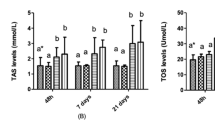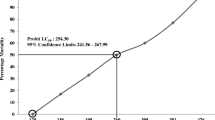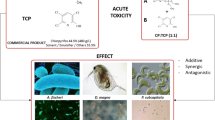Abstract
Perfluorooctane sulfonate (PFOS) is an anthropogenic compound found in trace amounts in many environmental compartments far from areas of production. This, along with the highly persistent nature of PFOS, presents a concern for possible effects in aquatic ecosystems. The objective of this study was to determine the toxicity of PFOS in representative freshwater organisms. Toxicity testing using standard laboratory protocols was performed on the green algae Selenastrum capricornutum and Chlorella vulgaris, the floating macrophyte Lemna gibba, and the invertebrates Daphnia magna and Daphnia pulicaria. No observable effect concentration (NOEC) values were generated from the most sensitive endpoints for all organisms. Autotroph inhibition of growth NOEC values were 5.3, 8.2, and 6.6 mg/L for S. capricornutum, C. vulgaris, and L. gibba, respectively. The 48-h immobility NOEC values for D. magna and D. pulicaria were 0.8 and 13.6 mg/L, respectively. In comparison to immobility, the 21-day lethality NOEC for D. magna was 5.3 mg/L. Based on effect (immobility) values, the most sensitive of all test organisms was D. magna. The most sensitive organism based on 50% inhibition of growth (IC50) was L. gibba, with an IC50 value of 31.1 mg/L determined from wet weight. This is 4.3 times less than the LC50 for D. pulicaria, which was 134 mg/L. Significant adverse effects (p ≤ 0.05) were observed for all organisms in concentrations >134 mg/L. The results indicate that under laboratory conditions PFOS is acutely toxic to freshwater organisms at concentrations at or near 100 mg/L. Based on known environmental concentrations of PFOS, which occur in the low ng/L to low μg/L range, there is no apparent risk to freshwater systems. However, further work is required to investigate long-term effects in these and other freshwater organisms.
Similar content being viewed by others
Author information
Authors and Affiliations
Additional information
Received: 2 May 2002/Accepted: 29 July 2002
Rights and permissions
About this article
Cite this article
Boudreau, T., Sibley, P., Mabury, S. et al. Laboratory Evaluation of the Toxicity of Perfluorooctane Sulfonate (PFOS) on Selenastrum capricornutum, Chlorella vulgaris, Lemna gibba, Daphnia magna, and Daphnia pulicaria . Arch. Environ. Contam. Toxicol. 44, 0307–0313 (2003). https://doi.org/10.1007/s00244-002-2102-6
Issue Date:
DOI: https://doi.org/10.1007/s00244-002-2102-6




